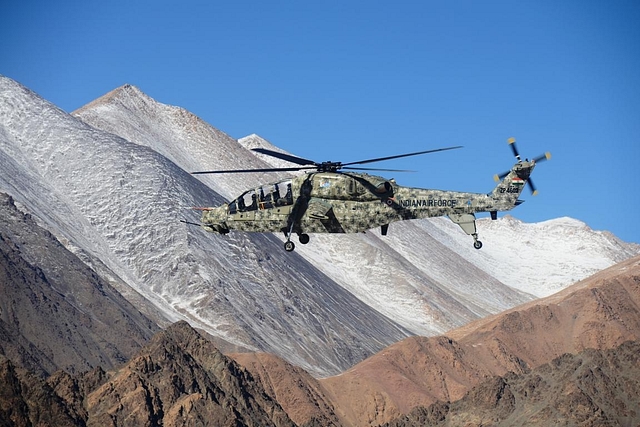
India’s Indigenous Light Combat Helicopter Deployed In Ladakh But It Is Still Without Its Most Crucial Weapons
The helo can also be armed with an air-to-air missile and an anti-armour missile — two weapons absolutely necessary for it to realise full potential in combat.
However, both these crucial weapons are currently missing on the LCH.
The Light Combat Helicopter (LCH), India’s first indigenously-built dedicated attack helicopter, is being operated by the Indian Air Force (IAF) in eastern Ladakh amid the ongoing military standoff with China.
Two of these helicopters, built by Hindustan Aeronautics Limited, reached Ladakh from Bangalore last weekend, a report in Livefist says. The helos are flying armed patrol sorties in the region amid reports of China’s unwillingness to move back its forces from areas it occupied along the Line of Actual Control in May.
This development came to light after Air Marshal Harjit Singh Arora, Vice Chief of the Air Staff, flew in one of two LCH helos deployed in Ladakh.
Posting a picture of Air Marshal Arora standing in front of an LCH airframe on Twitter, the IAf said that the Vice Chief flew the indigenous combat helicopter during his visit to forward air bases in the Ladakh sector on 7 August.
Air Marshal Arora, the report cited above says, flew the LCH from Thoise to Leh along with an HAL test pilot. The helicopter was flown in “full mission configuration... with temperatures as high as ISA + 36 degrees”, crossed various passes such as Khardung La and Chang La , carried out a simulated attack, and then demonstrated its maneuverability in simulated “aerial combat profile”.
The LCH has been built keeping in mind the requirements of the Indian military in high altitudes. The helo has demonstrated its capability of operating in high altitude conditions during trials not only in Ladakh but also on the Siachen Glacier.
Equipped with Shakti engine developed by HAL with French engine-maker Safran, the 5.5 tonne helo has been designed to operate at an altitude of up to 20,000 feet.
“During the Kargil War of 1999, there was a need felt for armed attack helicopters capable of operating at high altitude. That’s where the LCH fits in,” former IAF chief Fali Homi Major, the only helicopter pilot to become Chief of Air Staff, wrote recently.
The combat helicopter comes armed with a cannon mounted below its nose, capable of piercing light armour with a thousand 20-millimetre bullets each minute. It carries 70-millimetre rockets on pods on either side.
The helo can also be armed with an air-to-air missile and an anti-armour missile — two weapons absolutely necessary for it to realise full potential in combat. Both these crucial weapons are currently missing on the LCH, and it is solely dependent on its chin-mounted gun and 70-mm rockets for offensive operations.
MBDA’s Mistral air-to-air missile has been test-fired from the LCH, and the HAL has procured and integrated Mistral-specific launchers on the platform.
However, the missile is not yet part of the arsenal.
After years of negotiations and delay, the Ministry of Defence (MoD) told MBDA in 2018 that its offer was too expensive. Later that year, MBDA came up with a new offer with lower cost but there has been little to no movement on this front since.
According to HAL sources cited in this Livefist report, “the benchmarking of price for the Mistral missile was questionably low”.
“The benchmarking discrepancy, an MoD source said, was as much as 60 per cent. The HAL sources cited above said there was reason to wonder if someone was trying to ‘derail’ the procurement of missiles for... LCH,” the report reads.
The procurement of anti-tank missiles for LCH, a necessity given that the Chinese have deployed light tanks along the LAC amid the standoff, has faced delays.
While indigenous anti-tank missile HELINA is still in trials, Indian Army’s effort to arm it with a foreign anti-tank missile has’t moved forward.
Even as the helicopter waits for its weapons, HAL remains confident that the first order from the Indian military for the type will come “very soon”.
“We have concluded price negotiations. We are now awaiting financial sanction. By the end of this year, we should see the initial order for 15,” HAL chairman R Madhavan said recently, adding that he expects the numbers to go up to over 150.
HAL has already started working on five new air-frames so that it can deliver ahead of time when the first order for LCH arrives.